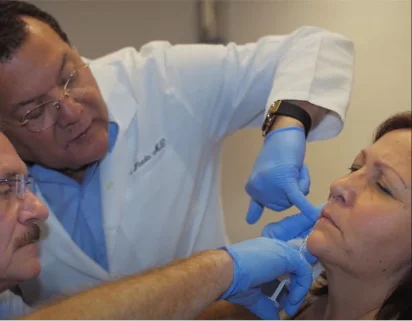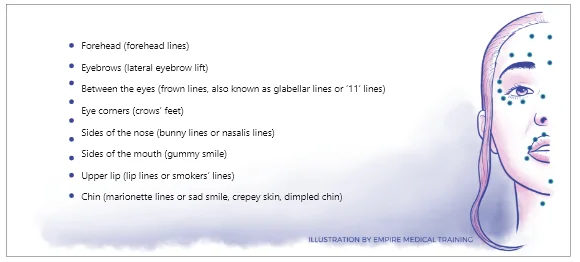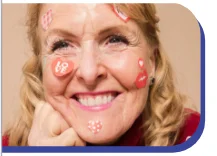Botox® Injection Sites Diagram
Neurotoxins | March 18, 2021

Botox® Injection Sites
Diagram
Entry made by
Empire Medical Training
Botox® is approved by the U.S. Food and Drug Administration to treat a range of cosmetic and non-cosmetic issues.
For many patients,
Botox is associated with cosmetic conditions of the face and neck, such as crows’ feet, glabellar lines, platysmal bands (neck lines), and various smile lines.
As you can see in this Botox injection sites diagram and
article, there are many facial sites that patients and providers alike need to be familiar with before seeking treatment or adding Botox to their practice.
Botox Injection Sites Diagram: Location and Dosage
This is a list of common Botox injection sites on the face and head, corresponding with the diagram shown here.
Each Botox injection site has unique physical characteristics, such as muscle mass (the single most important variable) and proximity to the neuromuscular junction. Accordingly, recommended dosing varies considerably between injection sites and procedures. As we’ll see, patient-specific factors may also affect dosing.
-
Forehead: Due to the extent of the forehead and the fact that forehead lines often span the entire region, forehead line injections typically require higher dosing than other fine-muscle treatments. The recommended range is 10 to 30 units, depending on
the extent of the treatment zone and patient-specific factors.
-
Eyebrows: Eyebrow shaping and lifting are finer procedures involving smaller muscle groups. The treatment area is relatively small as well, usually confined to the length of the eyebrow above the upper orbital bone. The standard dosing range is 2 to 5
units of Botox per eyebrow.
-
Between the eyes: This is an even more compact treatment area that occurs only once on each patient’s face. However, because frown lines can be deep and extensive, and the muscles involved are surprisingly massive, dosing is higher than for eyebrow shaping
and lifting. The recommended Botox dose ranges from 10 to 25 units.
-
Eye corners: This is one of the smallest facial treatment zones for Botox and involves some of the finest muscles safe to treat with the medication. Still, crows’ feet can be extensive and deep, necessitating higher dosing than might be expected. The
recommendation ranges from 5 to 15 units, depending on extent.
-
Sides of the nose: Bunny lines can extend from the nasal flare up through the nasal bridge and may require multiple injection sites. Depending on the lines’ depth and extent, the recommendation is 5 to 10 units per side.
-
Sides of the mouth: This complex of fine, shallow muscles does not require high volumes of Botox to remediate gummy smile. The dosing recommendation does not exceed 4 units in most cases.
-
Upper lip: The lip lines (smokers’ lines) that form above the lip tend to be fine and shallow, if pronounced. Dosing is suitably moderate, with no more than 8 units recommended to treat this condition.
- Chin: Botox is indicated or used off-label for several related cosmetic treatments of the chin, including marionette lines (smile lines) and dimpled chin (an age-related condition exacerbated by collagen loss). The recommended dosing for marionette lines rarely exceeds 6 units and can be lower, while the recommended dosing for dimpled chin generally ranges from 2 to 6 units.
- Anterior neck muscles: The muscles on the front (anterior) of the neck are vulnerable to age-related “banding” that’s visible in frontal and profile views of the patient’s face (above the neckline of most clothing tops). This condition is known as platysmal banding. Because these muscles are more robust than most muscles of the face and platysmal bands can be both deep and numerous, higher dosing is often required to address the problem to patients’ satisfaction — up to 50 units per treatment, though as little as 20 units may achieve the desired results in milder presentations.
Botox also has a number of non-cosmetic indications or off-label uses that involve muscles of the face and head:

-
Masseter muscles (jaw muscles): Botox may be injected into the masseter muscles, which run along the jawline on both sides of the face, in an off-label treatment for bruxism (involuntary jaw clenching). Dosing recommendations vary significantly, depending on the extent of the issue and patient-specific factors, but generally range from 20 to 30
units per side.
-
Temporalis and pterygoid muscles: These muscles on the side of the head and face are involved in temporomandibular joint (TMJ) dysfunction. Dosing recommendations also vary significantly.
-
Various head and neck muscles associated with chronic migraine: Botox is indicated for the treatment of chronic migraine,
with injection sites varying based on patient-specific presentations and pain sites. Some migraine treatments may require injections to the muscles of the forehead, side of the head, and neck, while others
may be limited to muscles of the shoulders and posterior head and neck.
Botox Dosing Considerations
A patient’s actual Botox dosing needs depend on procedure- and patient-specific factors that will only become clear after intake and initial consultation:
-
Patient gender: Patients who present as male generally have more muscle mass and may therefore require higher Botox doses to achieve the desired results.
-
Target muscles: As shown by the dosing ranges above, more massive muscles (such as the muscles of the shoulder and jaw) will require higher doses of Botox. Smaller muscles will require lower doses, all other factors being equal.
-
Patient age: Muscle mass generally declines with age, meaning older patients may not need as much Botox to produce similar results.
-
Prior patient outcomes: Although true Botox resistance is not common, tolerance can develop over time. Patients who required higher dosing in prior treatments should be expected to require higher dosing in future treatments.
Although no diagram can cover everything about Botox administration and dosing, this Botox injection sites diagram can enable aspiring practitioners and their patients to better understand facial treatment zones, dosing, and desired effects.


